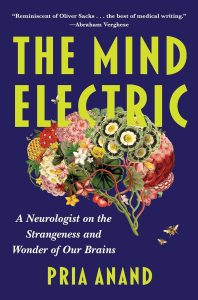Washington Square
Review by Walter Cummins

Pria Anand starts The Mind Electric by relating two childhood fascinations—her grandfather’s neurological symptoms from post-polio syndrome and, before she could read, the fantastical tales invented by her older sister. These—medical enigmas and storytelling— have remained passions throughout her life. Now, a successful academic neurologist, she has written a book that captures her unique ability to give voice to stories that illuminate her medical specialty.
One way of considering this book is as a collection of stories organized in chapters devoted to a related group of medical conditions and depicting them in action. For Anand, storytelling is essential for considering the phenomena around us. Her patient’s manifestations of an afflicted brain or body are revealed through a narrative, often placed in the context of a centuries-old myth or folk tale that described the behavior long before modern medicine revealed a likely neurological cause.
Anand writes about a range of her patients’ conditions and even makes herself one by including the challenges of her medical residencies and of her pregnancies. Beyond her knowledge, she is a gifted writer with a rich literary talent in the tradition of Oliver Sachs, whose works influenced her. For Anand, such creating is as essential to humans as breathing: “Stories allow us the make sense of the senseless.”
But, while a human necessity, the stories people relate may be make-believe no matter how vital they are for the teller. Patients who have lost control of their memories, and, therefore the ability to provide accurate accounts of what is happening to them, still offer narrative explanations. Anand calls these “confabulations,” her name for the imagining of stories: “A confabulation is not a falsification; unlike a fabulist, a confabulator has no intention to deceive, but he also has no insight that the stories he tells are entirely of his own invention.” Such stories have little connection to actual events. The confabulator substitutes replacements for the facts that have been lost to a disease and believes them.
At times the person with the disease is convinced that his or her alternative explanation is more valid than the medical one offered by the physician. Anand tells of a young woman with strong religious beliefs convinced that her temporary blindness is her punishment for the sin of kissing a young man; she refuses to believe Anand’s neurological analysis.
In other cases, Anand discusses patients who lose control of their brain because of an accident or infection. The resulting effects can cause issues such as the destroyed memory of Alzheimer’s disease or a much less common condition where victims believe the others around them, even family members such as one’s children, are imposters imitating the real people. In another illness, patients suffering obvious states such as blindness refuse to believe they have the problem.
Stories that attempt to make sense of mysterious happenings have existed for millennia, long before the findings of modern medicine. Anand cites a number of these tales that describe the manifestations of conditions only recently diagnosed by neurological studies with tools like MRIs. These tales, according to Anand, exemplify the value of stories in helping us grasp diseases the human species has endured throughout millennia.
One example is the Ondine myth in which the cursed lover of a water nymph—Ondine—will lose the ability to breathe if he stops thinking of her. Now the name Ondine’s curse is used for a rare syndrome where the brain fails to unconsciously regulate breathing.
In a varying example in which a modern literary work can incorporate a medical phenomenon, Virginia Woolf’s The Waves exemplifies the common condition of hearing voices through six friends alternating thoughts arising from their unconsciousness musings on the death of a friend.
As Anand acknowledges, it’s not only patients who misunderstand the actual causes of active medical conditions. She discusses the situation in nineteenth-century Paris in which Jean-Martin Charcot, an early neurologist, changed medical diagnosis by attributing behaviors such as seizures, paralysis, hallucinations, catalepsy, and trance-like states to hysteria as a neurological disorder rather than a gynecological illness. His Salpêtrière Hospital was a massive institution for women diagnosed with hysteria, where he had many of them perform their symptoms before a weekly audience of physicians and the general public. While Charcot disproved certain causes, his attribution of the conditions to the effects of hysteria faded as an explanation after his death. Anand now explains the current attribution of certain of these behaviors to Epstein-Barr virus and the resulting multiple sclerosis. While Charcot made a partial advance, his conclusions were wrong and his stories needed revision.
For Anand, diagnosis is only part of understanding. We specify explanatory details without perceiving the whole story. Narratives make a major contribution to filling in that story. She considers the impulse to tell and hear stories so coded in our brains that “it often survives and even surges after the most devastating of brain injuries.”
